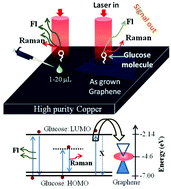Non-enzymatic glucose sensing by enhanced Raman spectroscopy on flexible ‘as-grown’ CVD graphene†
Abstract
Unmodified, as-grown few layered graphene on copper substrates have been used for glucose sensing using Raman spectroscopy. Graphene with a stronger 2D band is a better Raman enhancer with significant fluorescence suppression and finer line widths of the Raman signals. The origin of the graphene enhanced Raman spectroscopy (GERS) signal of glucose is attributed to a fractional charge transfer (calculated to be 0.006 using electrochemical parameters) between glucose and graphene aided by a possible π–π interaction. Physiological concentrations of glucose (10–500 mg dl−1) in PBS have been used for the study. For each glucose concentration, the spectral reproducibility is within 5–25% as calculated by the relative standard deviation of several measurements. The intensity ratio of the 1122 cm−1 peak of glucose and the 2D peak of graphene varied linearly with the glucose concentration and can be used as a calibration curve for unknown sample measurements.


 Please wait while we load your content...
Please wait while we load your content...